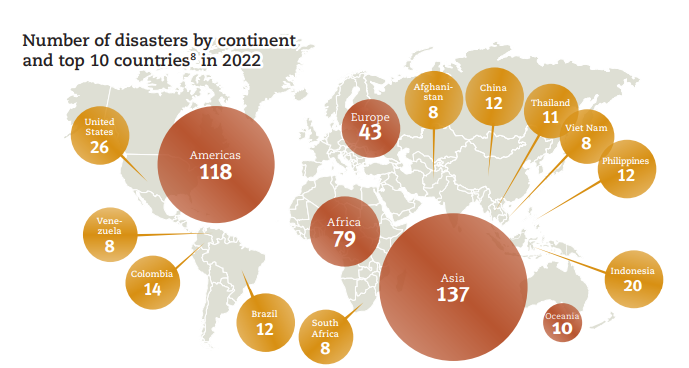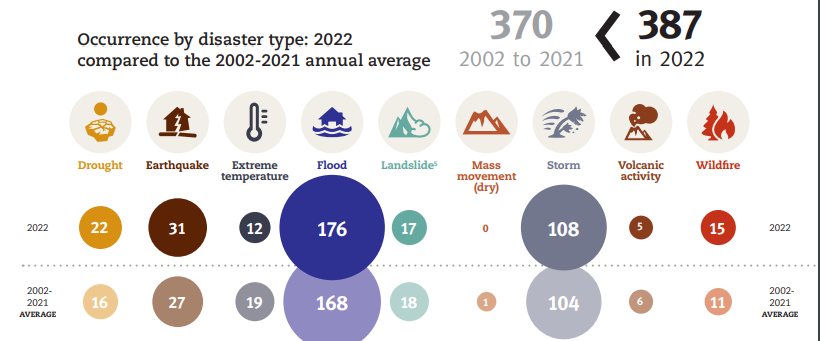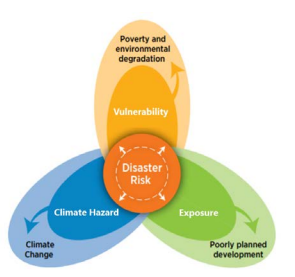“Climate change is like a fever, and the Earth is running a temperature. We must act swiftly to cool down the planet and avert the catastrophic consequences of rising disaster frequencies.”
Antonio Guterres, United Nations Secretary-General
Climate change has emerged as a pressing global challenge, impacting various aspects of our environment. One critical consequence is the increased frequency and intensity of climate-related natural disasters like floods, hurricanes, droughts, wildfires, heat waves, storms, landslides (as identified by UNCCS- UN Climate Change Secretariat) posing significant threats to communities worldwide. According to the Intergovernmental Panel on Climate Change (IPCC), the frequency of extreme weather events has increased by over 40% since the 1980s. The world is seeing an increase in the frequency of natural disaster occurrences.

Source: EM-DAT by CRED
As per the Emergency Event Database EM-DAT data, a total of 387 catastrophic events occurred in 2022 which is slightly higher than the average from 2002 to 2021 (370).

Source: EM-DAT by CRED
The occurrence of each type of disaster was also close to the average levels in the last two decades which affected approximately 185 million individuals. Although the causal relationship between climate change and natural disasters is not fully understood, we are still faced with the fact that the frequency of climate-related natural disasters is rising world over(Source: ADB Report). In the recent past, researchers have employed machine learning to analyze over 100,000 studies of weather events, revealing a clear pattern of more frequent and intense extreme weather events linked to global warming, affecting four-fifths of the world’s land area (Source: Nature Climate Change Journal). Human activities, such as burning fossil fuels and deforestation, are driving the rise in global temperatures, contributing to these alarming changes.
In India, the recent devastation caused by Cyclone Biparjoy (June 2023) and the floods in North India (July 2023) serve as a compelling reminder of the need to understand the link between climate change and disaster risk. This article is a compilation of literary works exploring this relationship, highlighting its significance in addressing the escalating impact of extreme weather events.
Climate change is defined as the shift in climate patterns mainly caused by greenhouse gas emissions. Greenhouse gas emissions cause heat to be trapped by the earth’s atmosphere, and this has been the main driving force behind global warming. The main sources of such emissions are natural systems and human activities. Statistical analysis by a research paper(Yue and Gao 2018) reveals that the earth’s natural system can be considered as self-balancing and that anthropogenic emissions add extra pressure to the earth system. Warming of the atmosphere and the ocean, changes in the global water cycle, reductions in snow and ice, the rising global mean sea level, and changes in some climate extremes are already being observed as GHG concentrations in the atmosphere continue to rise. As the planet warms due to human activities, the occurrence of extreme weather events like hurricanes, droughts, floods, and wildfires becomes more frequent and severe. So the intricate relationship between climate change and the frequency and intensity of disasters is a paramount concern not only for Governments, Climatologists and researchers but also for civilians as the impact of these events affects a country’s development trajectory and the livelihoods of its citizens.
Climate-related disaster risk is defined as the expected value of losses, often represented as the likelihood of occurrence of hazardous events multiplied by the impacts (effects on lives, livelihoods, health, ecosystems, economies, societies, cultures, services, and infrastructure), if these events occur.
Simply put:
Climate-related disaster risk = Likelihood of Occurrence of Hazardous event X
Impact if the event occurs
Disaster risks result from the interaction of three elements: (i) the hazard itself, (ii) the population exposed to the hazard (exposure), and (iii) the community’s ability to withstand its impact (vulnerability).

Out of all of them, Clearly, exposure is a big factor in disasters. Strong economic considerations drive that exposure. Communities, development projects and industries are built in flood-prone coastal areas because of the economic opportunities and services these areas provide, such as harbors and ports, energy needs, livelihoods, and transportation.
In the recent heavy rainfall and flash floods in Himachal Pradesh, Climate change also played a role, which led to increased heavy rainfall in hilly areas and surroundings due to extra moisture and orographic lifting. Land use changes and development activities aggravated the severity of flash floods. It has to be noted that flash floods caused by cloudbursts and extreme rainfall events are challenging to predict which increases the disaster intensity with landslides. Same was the case with Cyclone Biparjoy, which was expected to dissipate in the ocean as per IMD after the first few days. But IMD contended that Biparjoy intensified twice which wasn’t expected and this happened primarily due to the unusually warm waters of the Arabian Sea, attributed to global warming.
Coming to the third factor, numerous studies highlight the influence of income, education, and institutions on Vulnerability and disaster impacts. Researchers Thomas, Albert, and Hepburn (2014) focused on Asia and the Pacific, linking climate hazards, population exposure, and vulnerability to the frequency of intense natural disasters. Unlike prior analyses, they used disaster frequency as a more reliable measure, revealing the significant roles of population exposure and climate variability in driving climate-related disasters in the region ( Source: ADB Report). They also assessed that environmental degradation rendered many locations increasingly vulnerable to floods and storms.
When the Global occurrences of the Natural Disasters data by EM-DAT is observed, the United States stands at the top with the highest number of disasters ever faced with most of the other nations being from Asia. Adding the 2022 events(Figure 1) to the record that began in 1980 by NOAA National Centers for Environmental Information (NCEI), the U.S. has sustained 341 weather and climate disasters.

Rising temperatures due to climate change create conditions conducive to extreme weather events. Warmer oceans fuel the intensity of hurricanes(Ex: Hurricane Sandy) , increased evaporation leads to prolonged droughts (Ex: Western MegaDrought), and higher temperatures enhanced the risk of wildfires(Ex: 70,072 wildfires in USA since 2000) by drying out vegetation. These factors collectively increase the frequency and severity of these disasters.
Extensive research has established that the global surge in intense floods, storms, droughts, and heat waves has a likely and ominous link to human-induced climate changes. Climate change disproportionately affects vulnerable communities and fragile ecosystems. These groups struggle more during disasters because they lack resources to cope.
Frequent climate-related disasters lead to devastating economic and social consequences. The costs of recovery, loss of life and livelihoods, damaged infrastructure, and displacement strain economies and exacerbate poverty. The interplay between climate change and disaster frequency amplifies these challenges, underscoring the urgent need for effective mitigation and adaptation strategies. If sustained growth is to take place, the climate challenge must be met.
References:
ADB Report: https://www.adb.org/sites/default/files/publication/176899/ewp-466.pdf
Source: CRED. 2021 Disasters in numbers. Brussels: CRED; 2022. This document is available at: https://cred.be/sites/default/files/2021_EMDAT_report.pdf
Yue X-L, Gao Q-X (2018) Contributions of natural systems and human activity to greenhouse gas emissions. Adv Clim Change Res 9:243–252. https://doi.org/10.1016/j.accre.2018.12.003
Fawzy, S., Osman, A.I., Doran, J. et al. Strategies for mitigation of climate change: a review. Environ Chem Lett 18, 2069–2094 (2020). https://doi.org/10.1007/s10311-020-01059-w
https://www.ipcc.ch/site/assets/uploads/sites/2/2019/06/SR15_Full_Report_High_Res.pdf

